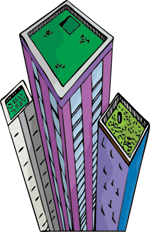The Concrete Advantage
Waterproof concrete makes green rooftops an even better investment for society and owners.
While the advantages of green roofs are many, the greatest downfalls have been significant additional construction costs and liability for designers, architects, installers, and owners. Projects constructed using truly waterproof concrete allow for the elimination of membranes, and therefore a simplification of the design, construction, and maintenance processes. This hydrophobic technology eliminates the riskiest element for the designer and owner of a green roof, increases financial viability, and enhances owner acceptance.
Features of Concrete Greenroofs
● Permanent “built-in” waterproofing, which cannot be punctured, torn or damaged in the construction phase or during service, or deteriorate with age. Such greenroofs are more financially viable, with less exposure risk for the owner and designer, which increases return on investment and project value.

● No need for the design and detailing of membranes results in reduced design time and costs for concrete greenroof projects. Once a structural concrete roof is designed, standard details for construction joints and service penetrations can follow.
● Construction savings are realized since “water-proofing” sub-contract works can be eliminated, advancing construction schedules by several weeks. Green roof decks do not require protection and are utilized as working platforms during construction. Faster construction directly enhances project viability.
● A lower square-foot cost saves money with concrete greenroofs, compared to greenroof membranes. Since there is nothing to wear out or replace, these projects have higher sustainability and a lower life-cycle cost.
● Cracks are quickly repaired with a simple injection from the bottom side of the greenroof deck, which does not disturb growing medium or plants.
Design, Construction and Cost Savings
Without having to design and detail any membranes, architects and designers save time, lowering the overall cost of the project. Constructability is simpler for the contractor, since he has no membrane to apply, or to worry about damaging in the construction process. The job is completed several weeks faster, since the contractor does not need to wait for the concrete to cure prior to applying a membrane. The use of waterproof concrete also eliminates the need for a root barrier in greenroof construction.
Thus far, there has been no FLL testing done to substantiate whether a root barrier can be eliminated. Roots do not seek water within the concrete because there is none in the waterproof concrete system. The elimination of the membrane can save several dollars per square foot, making the greenroof more economically viable for the owner. The fact that there is no membrane that needs replacement lowers the life-cycle costs, as well.
As long as the concrete is there structurally, the waterproof aspects will continue to perform. If there is a leak in a typical membrane system, it can be extremely difficult to trace and expensive to repair, causing damage and disruption to the plants and to the growing medium. If the waterproof concrete were to crack and leak, a simple polyurethane grout injection repair can be made from below, eliminating the need to disrupt the green roof. A leak can only come from a crack or an improperly-sealed penetration, so leak detection is obvious with the waterproof concrete system.


